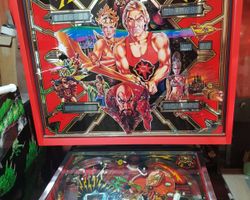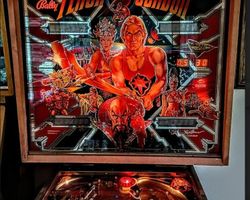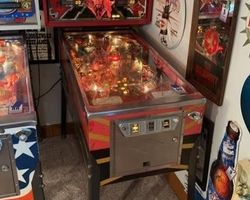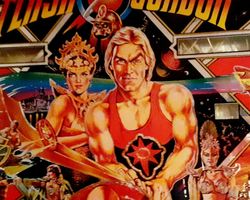Flash Gordon
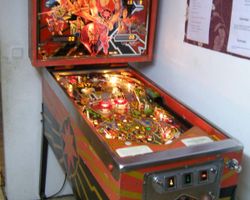
Average Prices: USD $200 to $2,100
Produced: Febuary, 1981
Production Run: 10,000 units
Machine Type: Solid State Electronic
MPU: Bally MPU AS-2518-35
Players: 4
Design by: Claude Fernandez
Art by: Kevin OConnor, Kevin O'Connor
Flash Gordon, released by Bally Manufacturing Co. in February 1981, transported players into the vibrant, cosmic world of the classic science fiction hero. Drawing direct inspiration from the highly anticipated 1980 live-action film, this pinball machine arrived with a compelling blend of thematic immersion and innovative mechanical design. The decision to base the machine on the contemporary film ensured its relevance and appeal, leveraging the visual style and narrative of a widely recognized property. Bally, a leading force in pinball manufacturing, aimed to capture the essence of Flash’s galactic struggle against Emperor Ming the Merciless, a villain who became intrinsically linked with the game itself through its distinct auditory features.
The machine's design was a collaborative effort. Claude Fernandez, known for his work on several Bally titles, handled the game design, meticulously crafting a playfield that challenged and engaged. Kevin O'Connor contributed the vibrant artwork, translating the film's aesthetic onto the backglass, playfield, and cabinet. His detailed renditions of characters like Flash, Dale Arden, and Emperor Ming captured the dramatic flair of the source material. Rehman Merchant was responsible for the software, bringing the game's logic and revolutionary sound elements to life. Produced in a substantial run of 10,000 units, Flash Gordon marked several significant milestones for Bally. It was the company's first production machine to feature a split-level playfield, a design choice that profoundly impacted gameplay. Furthermore, it was the inaugural game to incorporate Bally's "Squawk & Talk" board, a groundbreaking sound system that enabled sophisticated speech capabilities. While Bally's 1980 machine, Xenon, was their first production game with speech, Flash Gordon was the first to fully leverage the Squawk & Talk board's advanced features, delivering distinct voice lines, including the memorable taunts of Emperor Ming. Early production units even featured a high-intensity strobe light in the backbox, visible through a clear section of the upper backglass, a feature that was later removed due to player feedback regarding its intensity.
Signature Features and Design
Flash Gordon distinguishes itself through a collection of unique features that elevate its gameplay and thematic presentation. The most prominent of these is the innovative split-level playfield. This dual-level design, a first for Bally, introduces verticality and strategic depth, compelling players to master shots to both the lower and upper sections. This architectural choice enhances the gameplay experience by offering varied shot opportunities and demanding precise ball control, setting it apart from many contemporary machines.
Beyond its structural innovation, Flash Gordon was a pioneer in auditory design. It was the first production game to fully utilize Bally’s "Squawk & Talk" board. This system delivered custom speech call-outs, most notably the ominous pronouncements of Emperor Ming. These vocalizations, such as "Pathetic Earthlings… Who can save you now?", became synonymous with the game, providing thematic reinforcement and direct in-game feedback that intensified the player's interaction. The integration of speech for direct character engagement was a significant leap forward in pinball machine design, adding a layer of immersion previously unattainable.
The machine's artwork by Kevin O'Connor is another defining characteristic. The backglass, in particular, is a vibrant tableau depicting key characters and scenes from the 1980 film, executed with a dynamic, comic book-inspired style. The playfield art similarly reinforces the sci-fi theme with cosmic backdrops, detailed character likenesses, and thematic elements like the "Wood Beast," a subtle nod to the film’s fantastical elements. The combination of intricate artwork and responsive lighting creates an environment that transports the player into Flash Gordon’s universe, making each shot feel like a pivotal moment in the battle against Ming.
Playfield and Mechanics
The playfield of Flash Gordon is a masterclass in strategic layout, defined by its pioneering split-level design. The lower playfield serves as the primary battleground, featuring a generous arrangement of targets and shots. Three flippers, two on the lower playfield and one dedicated to the upper, provide distinct shot angles and control. Prominent among the lower playfield elements are the drop targets, strategically placed to encourage diverse shotmaking. These include a 4-bank drop target set, a 3-bank, and three-in-line drop targets, totaling eleven targets that reset as an objective. Two spinning targets offer high-scoring opportunities when struck repeatedly, rewarding accurate, sustained shots.
The design philosophy behind the layout emphasizes precision and strategic progression. Shots to the lower playfield aim to clear drop targets and build bonus, while successful shots towards the ramps are crucial for reaching the elevated upper playfield. Three distinct ramps guide the ball to different sections, including the upper level. Once on the upper playfield, players encounter an additional set of targets and a two-way kick-out hole, which provides a challenging recovery shot back to the lower playfield or a path to score points on the upper level. This multi-leveled arrangement creates a flow that is both challenging and rewarding, demanding a keen understanding of ball trajectory and shot timing.
The artwork on the playfield is vibrant and detailed, perfectly complementing the cosmic sci-fi theme. Rich blues and purples dominate the background, accented by bright yellows and reds that highlight key targets and shot lanes. Characters from the movie are emblazoned across the playfield, visually guiding the player to specific objectives. The lighting scheme, utilizing numerous general illumination bulbs and strategically placed controlled lamps, further enhances the aesthetic. Lights flash to indicate active targets or successful shots, drawing the player's eye and reinforcing the thematic elements, culminating in a cohesive visual experience that reinforces the battle against Emperor Ming.
Gameplay Dynamics
Flash Gordon's gameplay dynamics are characterized by their fast pace, demanding precision, and a rewarding challenge that compels players to continue. The core progression revolves around clearing the extensive array of drop targets, which are strategically distributed across both the lower and upper playfields. Each set of targets, including the 4-bank, 3-bank, and 3-in-line, offers distinct scoring opportunities and contributes to the overall bonus. Completing these target banks often opens up access to ramps or special features, creating a clear sense of objective and achievement.
The scoring system encourages a multifaceted approach. While drop targets are a primary focus, accurate shots to the spinning targets rapidly accumulate points, and consistent hits on the ramps not only advance play but also build score multipliers. The upper playfield functions almost as a miniature game in itself, with its own set of objectives and a separate bonus system, adding a layer of complexity to the scoring strategy. Successful navigation and scoring on the upper level require precise shots from the lower playfield's flippers, testing a player's ability to control the ball with accuracy.
Unique to Flash Gordon is the relentless auditory presence of Emperor Ming. His taunts, delivered through the "Squawk & Talk" board, are not merely cosmetic; they punctuate the gameplay, sometimes mocking player failures and at other times reacting to significant scores, adding an adversarial element to the experience. For instance, successfully clearing a bank of drop targets might be met with a disparaging remark from Ming, driving the player to push further. The game's primary objective is to achieve a high score through a combination of clearing targets, hitting spinners, and mastering the multi-level shots. It is largely a single-ball experience, placing a premium on ball control and extended play. The challenge of keeping the ball in play, particularly with its notoriously unforgiving outlanes, makes every successful shot and every sustained ball time a significant accomplishment. This demanding nature ensures that each game is a test of skill, fostering a strong "one more game" desire among players.
Reception and Legacy
Flash Gordon entered the pinball market as a demanding yet compelling machine, eliciting a range of feedback from the pinball community. Its primary strength, frequently cited by enthusiasts, is its engaging and challenging gameplay. Players consistently highlight the fast pace and the necessity of precise shot execution, particularly given the unforgiving nature of the outlanes. This high level of difficulty, while frustrating for some new players who experience short ball times, is precisely what appeals to others, who value the skill-based challenge and the sense of accomplishment derived from mastering its intricate shots. The game's strong thematic integration, particularly through its vibrant artwork and the distinct voice call-outs of Emperor Ming, is another universally praised aspect, deeply immersing players in the sci-fi narrative. For many, the opening theme from the film and Ming's taunts remain etched in memory as defining elements of the machine. The innovative split-level playfield, a first for Bally, also received considerable positive attention, contributing to the machine’s depth and replayability.
Conversely, the machine’s intense difficulty is also its most frequent point of criticism. Some players describe it as "brutal" or a "drain monster," particularly for those less accustomed to its demanding playfield geometry. While the upper playfield is acknowledged for adding complexity, the overall layout, including the positioning of the kick-out hole, requires constant vigilance. Despite these challenges, the underlying design of the playfield is often lauded for its logical flow and the variety of shots available, from the numerous drop targets to the three ramps and two spinners.
Flash Gordon holds a significant legacy within pinball history. It is recognized as a pivotal early solid-state machine that pushed boundaries, particularly with its pioneering use of the split-level playfield for Bally and its robust implementation of speech via the "Squawk & Talk" board. Its influence can be seen in subsequent multi-level designs that aimed to replicate or expand upon its vertical gameplay. Often compared to other multi-level games, it maintains its own distinct identity due to its unique rule set and the direct, skill-focused gameplay. For many, Flash Gordon remains a classic, appreciated for its blend of thematic spectacle, challenging play, and its place in the evolution of pinball technology, continuing to command respect and affection within the collector community for its enduring replay value.
Sponsored Links
 Ebay Listings
Ebay Listings
 Auction Results
Auction Results
| Cost | Location | Date |
|---|---|---|
| USD $5,500 |  Virginia, United States Virginia, United States |
11 October, 2025 |
| USD $3,800 |  California, United States California, United States |
26 September, 2025 |
| EUR €1,420 |  Baden-Württemberg, Germany Baden-Württemberg, Germany |
06 September, 2025 |
| USD $2,975 |  Arkansas, United States Arkansas, United States |
06 April, 2025 |
| USD $3,000 |  Maryland, United States Maryland, United States |
28 February, 2025 |
| USD $5,000 |  Georgia, United States Georgia, United States |
10 January, 2025 |
| GBP £1,900 |  United Kingdom United Kingdom |
15 December, 2024 |
| USD $3,500 |  Nebraska, United States Nebraska, United States |
10 October, 2024 |
| USD $2,000 |  Texas, United States Texas, United States |
19 June, 2024 |
| USD $2,999 |  Florida, United States Florida, United States |
21 February, 2024 |


Private Policy · Search Website · Contact Us
As an eBay Partner, we may earn a commission from qualifying purchases made through links on this site, at no additional cost to you.
All trademarks and copyrighted materials remain property of their respective owners. All other content copyright 2007 - 2025 Pinpedia.

